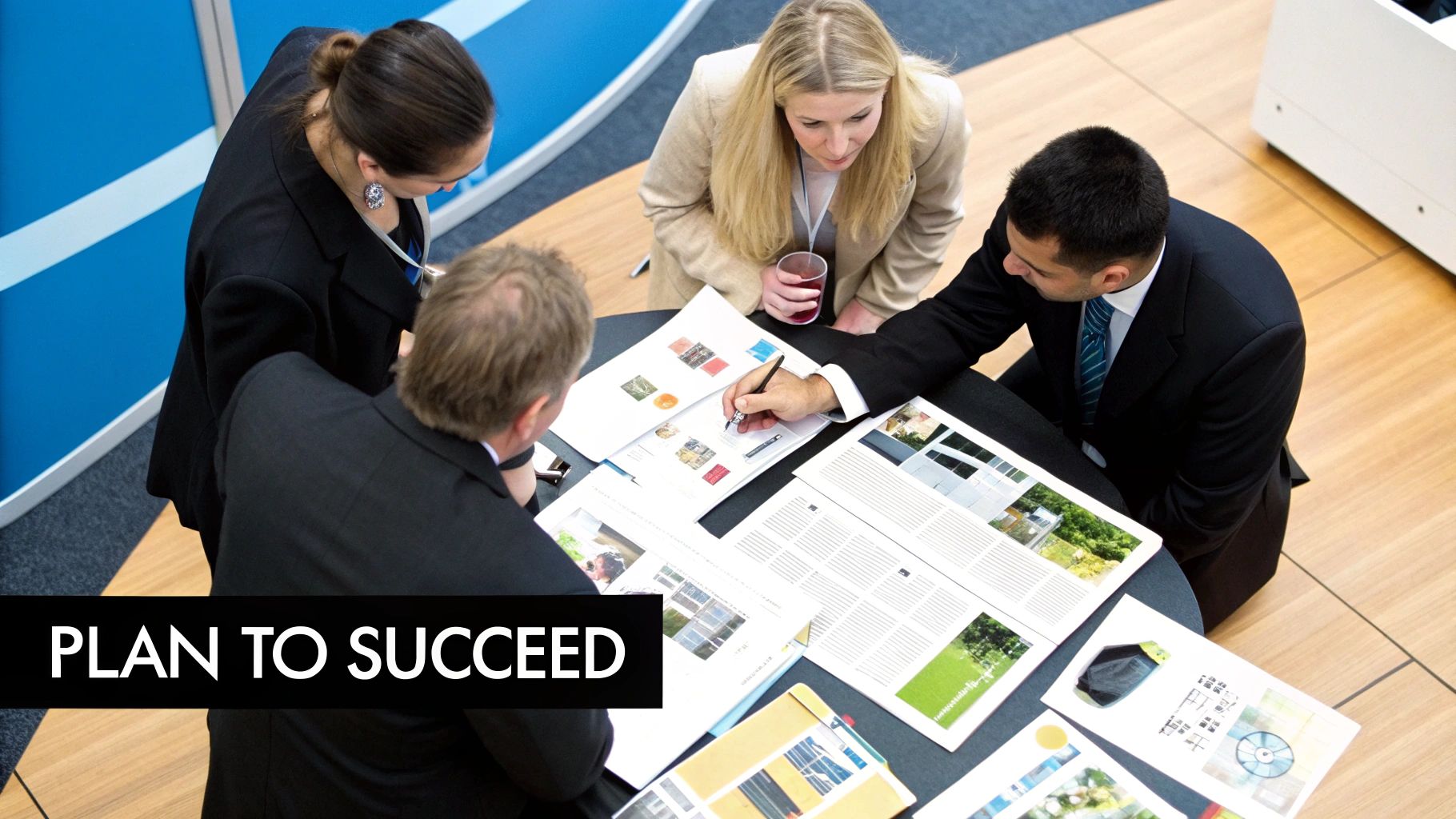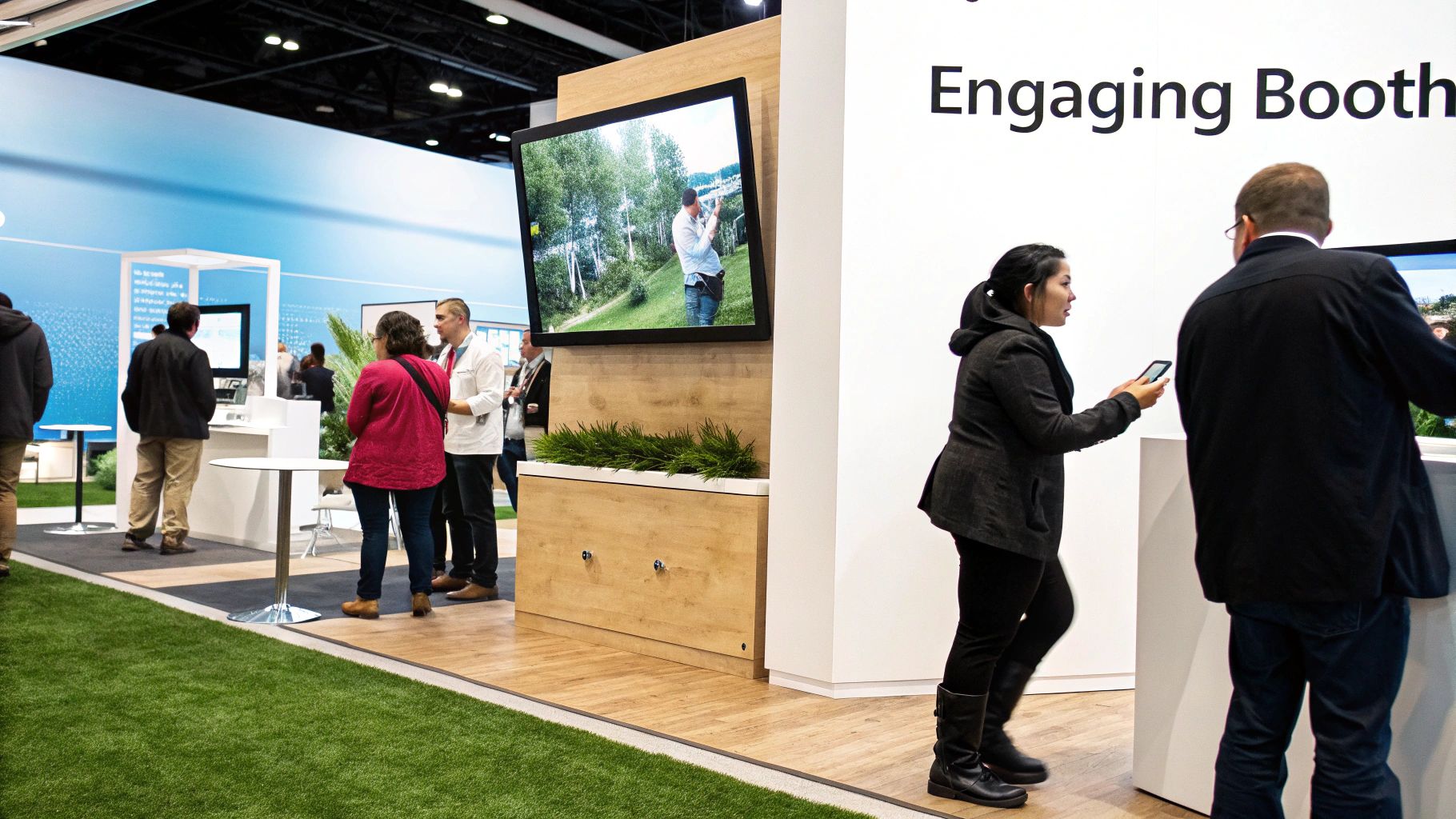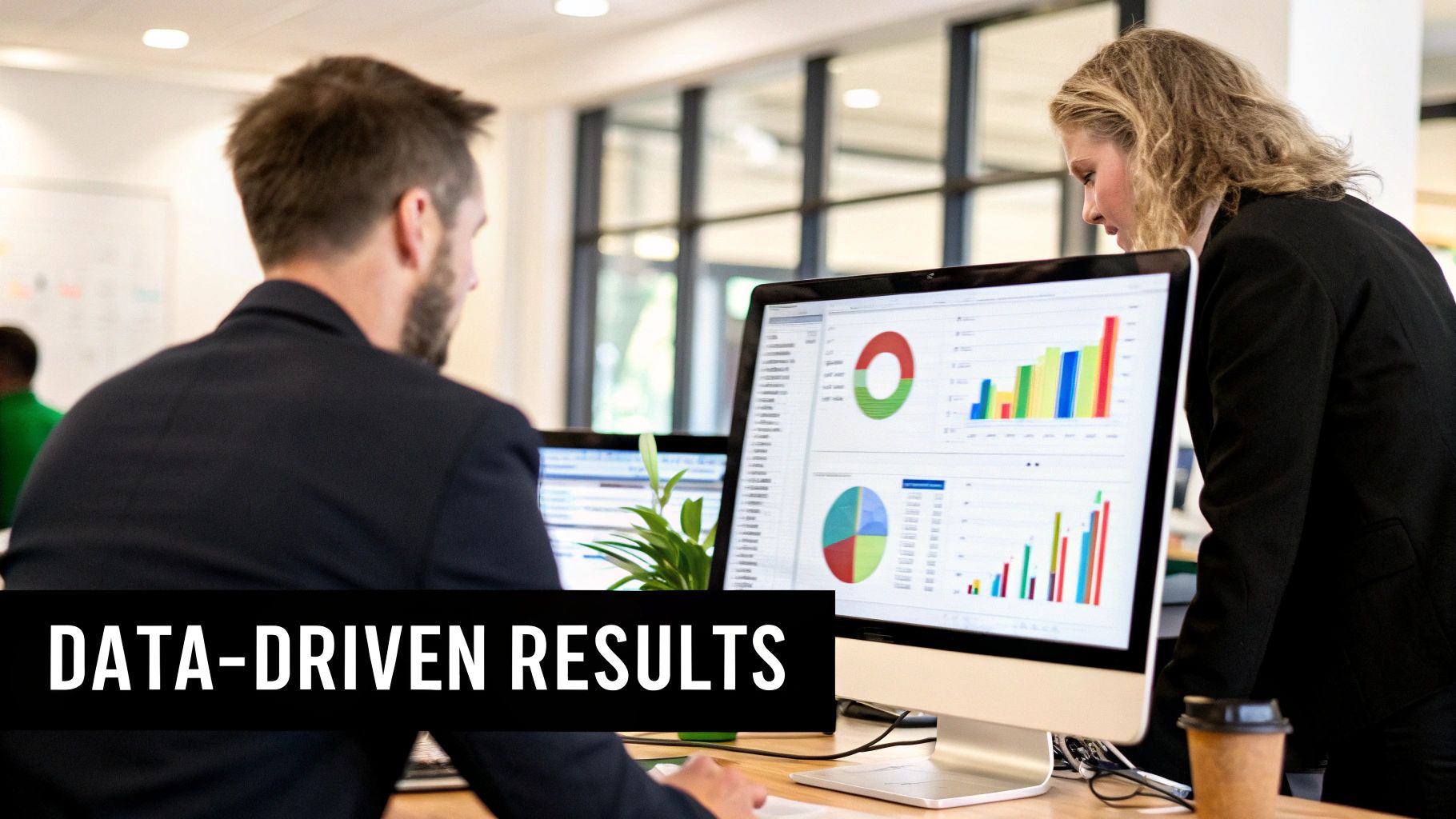Mastering Trade Show ROI: Proven Tactics
Beyond Booth Visitors: What Trade Show ROI Really Means

Simply collecting a stack of business cards doesn't equate to a successful trade show. True trade show ROI extends far beyond the number of booth visitors. It involves looking past superficial metrics like foot traffic and focusing on the real, lasting impact.
For example, consider the value of the long-term relationships you form and the boost to brand awareness. These are crucial aspects of a successful trade show, yet often overlooked by traditional ROI calculations.
Redefining Success: A Broader Perspective on ROI
Many companies struggle to justify their trade show budgets because they focus solely on immediate sales. Experienced exhibitors, however, understand that trade show ROI is a much broader concept.
It encompasses immediate sales leads, of course. But it also includes less tangible, yet equally important benefits like brand building, market research, and networking opportunities. This shift in perspective is key to understanding the true value of trade shows.
This holistic view of trade show ROI incorporates several key elements. One crucial factor is lead quality over lead quantity. A smaller number of highly qualified leads is far more valuable than a large volume of less-interested attendees.
Building brand awareness within your target audience is another significant factor. Strengthening relationships with key players in your industry contributes to long-term growth and should absolutely be factored into your ROI assessment.
Speaking of tangible returns, trade shows have a proven track record of profitability. Studies show that between 5% to 10% of trade show leads convert into sales or partnerships. This can fuel significant growth for businesses.
Furthermore, 14% of Fortune 500 companies report a 5:1 ROI on their trade show investments – meaning they earn $5 for every $1 spent. This impressive return highlights the importance of strategic planning, impactful booth design, and having a skilled team on-site. For a deeper dive into trade show ROI statistics, check out this resource: Learn more about average trade show ROI.
The Comprehensive Measurement Framework
Successful companies utilize a comprehensive measurement framework that considers both the immediate and long-term impacts of their trade show presence. This goes beyond simply counting leads.
Instead, it delves into metrics that truly reflect the value generated. This might involve tracking the progression of leads through your sales pipeline, measuring the increase in brand mentions on social media platforms following the event, or quantifying the value of newly established partnerships.
By adopting this broader perspective on trade show ROI, companies can significantly improve their approach and unlock the full potential of these events. This involves setting clear, measurable objectives, developing targeted strategies, and implementing a robust measurement system.
The result? A more strategic and, ultimately, more profitable trade show experience. This approach not only justifies the investment, but also makes a significant contribution to long-term business growth.
Metrics That Matter: Measuring Trade Show ROI Effectively

Trade shows represent a significant investment for businesses. Moving beyond simply counting booth visitors, it's crucial to analyze Key Performance Indicators (KPIs) that genuinely reflect your return on investment. Understanding how industry leaders measure success across various aspects of their trade show presence provides valuable insights. Let's explore which metrics genuinely matter and which can be misleading.
Beyond Lead Quantity: Focusing on Quality
While the total number of leads collected at a trade show offers a starting point, it doesn't provide a complete picture. A critical element of evaluating trade show ROI lies in assessing lead quality. This is where the concept of Marketing Qualified Leads (MQLs) becomes important. MQLs are leads that demonstrate a higher probability of converting into paying customers.
Average-performing teams typically generate approximately one MQL for every seven booth interactions. However, top-performing teams often achieve two to three MQLs per seven leads. This stark difference underscores the importance of effective lead qualification during the event itself, followed by prompt and strategic follow-up activities. Metrics such as the number of qualified leads, cost per lead, and lead follow-up time offer a comprehensive view of trade show performance. For a deeper dive into effective lead qualification and follow-up strategies, check out this resource: Find more detailed statistics here.
Building a Custom ROI Dashboard
To accurately gauge trade show ROI, developing a personalized dashboard aligned with your specific business objectives is paramount. This framework should reflect your unique goals, whether they revolve around boosting brand awareness, expanding market reach, or driving direct sales.
This tailored dashboard guides your metric selection and tracking. It ensures you're concentrating on the data points most relevant to your business, leading to more precise and insightful ROI calculations.
Key Metrics for Different Objectives
The most relevant metrics will vary based on your primary goals. If your focus is brand awareness, tracking social media mentions and website traffic following the event might be paramount. This provides valuable data on the reach and impact of your trade show presence.
However, if sales generation is your main objective, monitoring the conversion of leads into opportunities and ultimately, closed deals, becomes the primary focus. Understanding these nuances is crucial for constructing a truly effective ROI measurement system. The following table provides a comparison of key metrics depending on your objectives:
To help illustrate how to tailor your ROI measurements, consider the following table:
Trade Show ROI Measurement Matrix: Comparison of essential metrics for measuring trade show ROI across different business objectives.
| Metric | Sales Focus | Brand Awareness Focus | Launch/Product Focus | Implementation Difficulty |
|---|---|---|---|---|
| Number of Qualified Leads | High Importance | Medium Importance | High Importance | Easy |
| Cost Per Lead | High Importance | Low Importance | Medium Importance | Medium |
| Lead Follow-Up Time | High Importance | Low Importance | Medium Importance | Easy |
| Social Media Mentions | Low Importance | High Importance | High Importance | Medium |
| Website Traffic | Medium Importance | High Importance | High Importance | Easy |
| Conversion Rate (Leads to Opportunities) | High Importance | Low Importance | Medium Importance | Medium |
| Closed Deals | High Importance | Low Importance | Medium Importance | Hard |
| Product Demo Requests | Low Importance | Medium Importance | High Importance | Easy |
| Media Coverage | Low Importance | High Importance | High Importance | Hard |
This table provides a starting point for tailoring your ROI measurements to your specific goals. Remember that the "Implementation Difficulty" is a relative measure and can vary depending on your existing systems and processes.
Measuring Post-Event Engagement
The true impact of a trade show extends well beyond the event itself. Tracking post-event engagement is vital to understanding the lasting effects of your participation. This long-tail impact can often be a significant contributor to overall ROI.
This might involve monitoring website visits originating from leads acquired at the show, measuring social media interactions related to your brand after the event, or analyzing the long-term progression of leads through your sales pipeline. This enables you to directly link your trade show activities to tangible revenue and gain a more accurate picture of your overall ROI.
By concentrating on these essential metrics and developing a tailored measurement system, you can move beyond superficial evaluations and gain a profound understanding of your true trade show ROI. This strategic approach empowers you to optimize future trade show strategies and maximize the value of your investment.
Pre-Show Planning That Sets the Stage for Success

Maximizing your trade show ROI begins well before the event itself. Careful pre-show planning is essential for a successful trade show strategy. By examining the practices of consistently successful exhibitors, we can pinpoint key steps that pave the way for measurable results. This includes setting clear objectives, selecting the right shows, and drumming up pre-show excitement to draw in qualified prospects.
Defining Your Objectives and Choosing the Right Show
Start by outlining clear, measurable objectives that align with your overall business goals. Is your primary focus lead generation, brand awareness, product launches, or a combination of these? For additional information and related content, this resource may be helpful: trade show blog.
Once your objectives are defined, research and choose the trade shows that best fit your target audience and industry. Attending the wrong show can significantly affect your trade show ROI, making careful selection crucial. This involves examining attendee demographics, researching the event's competitive landscape, and evaluating how well the show aligns with your business objectives.
The economic significance of trade shows highlights their potential. In 2019, U.S. spending on trade shows reached $15.6 billion. Trade shows are also vital for generating new business, with companies attributing approximately 33% of their annual new business to these events. Furthermore, 72% of attendees are more likely to buy from an exhibitor they met at a trade show than from a competitor they haven't. This emphasizes the importance of maximizing your presence. Learn more about trade show statistics
Building Pre-Show Buzz and Optimizing Booth Design
Creating excitement before the event is critical for drawing qualified leads to your booth. This can include targeted email marketing, social media engagement, public relations efforts, and pre-show advertising. These initiatives build anticipation and ensure your target audience knows you'll be at the show.
In addition, optimize your booth design to create a captivating and memorable attendee experience. Consider factors like booth layout, lighting, graphics, and interactive elements. A well-designed booth can significantly improve lead generation and brand awareness, directly contributing to a positive trade show ROI.
Staff Preparation and Promotional Strategies
Preparing your booth staff is another key element of pre-show planning. Make sure your team is knowledgeable about your products, target audience, and overall trade show strategy. Thorough staff training can significantly impact visitor engagement and lead qualification.
Also, develop targeted promotional strategies to attract the right attendees to your booth. This might involve offering exclusive show discounts, running interactive demonstrations, or giving engaging presentations. These activities generate excitement and draw attention to your booth.
Creating a Realistic Timeline and Identifying Potential Pitfalls
Establish a realistic timeline for each stage of your pre-show planning process. This helps ensure you stay on schedule and avoid last-minute rushes. A well-defined timeline keeps your team organized and allows adequate time for each task.
Be mindful of potential problems that can disrupt your pre-show preparations. These could include unclear objectives, insufficient staff training, or ineffective promotional strategies. By identifying these potential issues early, you can take proactive measures to minimize their impact and maximize your trade show ROI.
By carefully planning and addressing these key aspects months in advance, you build a solid foundation for trade show success and a strong return on your investment. Thorough preparation is the first step toward achieving your desired trade show ROI. This meticulous approach sets you up to not only meet but also surpass your trade show goals.
On-Site Execution: Converting Conversations to Real Value

Even with the most detailed planning, a substantial trade show ROI depends heavily on effective on-site execution. This means making the most of every interaction during the event itself. By learning from experienced trade show professionals, we can explore practical strategies for booth staffing, lead qualification, and technology integration for a truly impactful presence.
Booth Staffing: The Human Element
Effective booth staffing isn't just about having bodies; it's about having the right people equipped with the right skills. Your booth staff are your brand ambassadors. They are the face of your company, creating first impressions and engaging attendees in valuable conversations.
A strategic mix of sales-oriented staff and product experts can be incredibly effective. This combination allows for both efficient lead qualification and provides in-depth answers to visitor questions. Sufficient staffing also ensures that your team doesn't miss any potential leads, especially during busy periods.
Qualifying Leads: Separating the Wheat from the Chaff
Efficiently identifying high-potential prospects is key to maximizing your trade show ROI. This goes beyond simply scanning badges and piling up business cards. It's about having genuine conversations, understanding attendee needs, and determining if they are a good fit for your products or services. This means asking insightful questions and actively listening to responses.
A standardized lead qualification process is essential. Implementing a lead scoring system can be particularly helpful for quick assessment and categorization. This approach ensures that your team focuses its follow-up efforts on the most promising leads, optimizing your post-show activities.
To illustrate a practical lead qualification process, consider the following framework:
To help categorize and prioritize leads, the following table provides a data-driven approach:
Trade Show Lead Quality Assessment Framework: Data-driven approach to quickly categorize and prioritize leads gathered during trade shows
| Lead Quality Level | Identifying Characteristics | Recommended Follow-up Timeline | Conversion Probability |
|---|---|---|---|
| Hot Lead | Expresses immediate need, has budget authority, and aligns perfectly with your ideal customer profile | Within 24 hours | High |
| Warm Lead | Shows interest, but needs further nurturing to understand their needs and budget | Within 48-72 hours | Medium |
| Cold Lead | Gathers information, but expresses no immediate need or doesn't fit your target customer profile | Within 1 week (if at all) | Low |
This framework provides a structured method for efficient lead management, allowing you to concentrate resources on the most promising opportunities and maximizing your trade show ROI.
Technology: Enhancing the Experience and Capturing Data
Technology is a powerful tool for improving the visitor experience and gathering valuable data. This extends beyond basic lead retrieval systems. Think interactive displays, compelling product demonstrations, and engaging presentations that draw attendees in and create a memorable brand experience.
Integrating technology with your CRM (Customer Relationship Management) system streamlines lead capture and ensures that valuable data is efficiently transferred to your sales team. This seamless data flow allows for personalized follow-up and contributes to a more effective lead nurturing process.
Real-Time Adjustments: Optimizing Throughout the Event
Finally, be prepared to adapt your strategies on the fly, based on attendee feedback and traffic patterns. The ability to adjust in real-time is vital for maximizing your trade show ROI.
This might involve shifting booth staff to meet demand, refining your messaging based on attendee interest, or tweaking promotional offers. This dynamic approach allows you to continuously optimize your performance throughout the event. By actively monitoring and responding to the live environment, you ensure you're getting the maximum return from your trade show investment. Effective on-site execution is the key to turning conversations into tangible results and achieving a strong trade show ROI.
Post-Show Follow-Up: Where Trade Show ROI Is Won or Lost
The trade show may be over, but the real work has just begun. Maximizing your trade show ROI hinges on a strategic post-show follow-up. This is the crucial phase where connections transform into tangible business results. It's the difference between a successful event and a missed opportunity.
The Importance of a Timely Response
Top-performing companies understand the impact of a quick follow-up. Those consistently achieving a 5:1 ROI prioritize connecting with leads within 24-48 hours. This promptness keeps your brand top-of-mind and prevents leads from going cold. A swift response demonstrates professionalism and reinforces your interest in their needs. It sets a positive tone for future interactions and helps move leads through the sales pipeline.
Segmenting Your Leads for Personalized Outreach
Effective follow-up requires a tailored approach. Segmenting your leads based on engagement and interest level allows for personalized communication. Consider categorizing leads as "hot," "warm," or "cold."
-
Hot leads show immediate buying intent and require immediate, personalized attention. A direct phone call or a detailed email addressing their specific needs is crucial.
-
Warm leads benefit from targeted email sequences. Provide further information about your products or services to nurture their interest and guide them toward a decision.
-
Cold leads might receive a general thank-you email or be added to a broader marketing list for future campaigns.
This strategic segmentation maximizes efficiency and effectiveness, ultimately boosting your trade show ROI.
Content Strategies to Maintain Momentum
Maintaining engagement after the initial contact is essential. Develop a content strategy that delivers value and keeps leads connected with your brand. This could involve offering exclusive content, sharing industry insights, or providing specialized resources.
Consider offering a post-show webinar, a downloadable white paper, or a free consultation. Providing ongoing value positions your brand as a trusted resource and strengthens relationships with potential clients.
Implementing a Structured Follow-Up Process
A structured follow-up process is fundamental to post-show success. It ensures that no qualified lead slips through the cracks. This structured approach includes:
- Defining clear responsibilities within your sales and marketing teams.
- Establishing a consistent follow-up schedule.
- Using marketing automation tools to streamline communications.
This systematic approach facilitates efficient lead nurturing through the sales pipeline. It also provides valuable metrics for measuring your trade show ROI and evaluating the effectiveness of your post-show activities. Automation ensures consistent and timely communication for maximum impact.
By prioritizing timely responses, personalized outreach, valuable content, and a structured process, you can effectively nurture leads and maximize your trade show ROI. This strategy not only converts connections into customers but also cultivates lasting relationships that contribute to long-term business growth. The true value of a trade show lies in the ongoing engagement after the event concludes.
Tech Stack Essentials for Tracking Trade Show ROI
The right technology can significantly impact how you measure and optimize your trade show ROI. This section explores the essential tools successful exhibitors use to track real returns efficiently. From lead capture solutions designed for the busy trade show floor to CRM integration that connects booth activities directly to your sales pipeline, we'll explore practical systems for various budgets.
Lead Capture: Ditch the Business Cards
Traditional business cards are inefficient and easily lost. Modern lead capture solutions provide a far more effective way to gather and manage prospect information. These systems range from simple mobile apps to dedicated lead retrieval systems.
-
Lead Retrieval Systems: These specialized devices often use badge scanning to quickly capture attendee information. They streamline lead collection, minimize manual data entry, reduce errors, and save valuable time.
-
Mobile Apps: Several apps offer lead capture functionality, often integrating with your CRM (Customer Relationship Management). These apps provide flexibility and portability, enabling your team to capture leads anywhere on the trade show floor.
-
Digital Forms: Using tablets or laptops with customized digital forms allows you to collect specific information relevant to your business and qualify leads more effectively during the event.
The best lead capture method depends on your budget and needs. A small business might find a mobile app sufficient, while a larger enterprise might benefit from a robust lead retrieval system.
CRM Integration: Connecting the Dots
Integrating your lead capture solution with your CRM system is essential for seamless follow-up. This integration automatically transfers lead data directly into your CRM, eliminating manual entry and ensuring no valuable lead is missed.
This connection enables your sales team to quickly access lead information, personalize follow-up communications, and efficiently track leads through the sales pipeline. This direct link between booth activity and your sales process is vital for accurate attribution and meaningful analytics, contributing directly to calculating and improving your trade show ROI.
Data Analytics: Measuring What Matters
Beyond lead collection, analyzing data is crucial to understanding what works. Data analytics tools can provide valuable insights into your trade show performance.
-
CRM Reporting: Most CRMs offer built-in reporting features that provide data on lead conversion rates, sales pipeline progression, and overall trade show ROI.
-
Marketing Automation Platforms: These platforms offer more advanced analytics, allowing you to track lead engagement across multiple channels, measure follow-up campaign effectiveness, and identify areas for improvement.
By analyzing this data, you can pinpoint which trade shows generate the highest quality leads, refine your pre-show planning, optimize on-site execution, and improve post-show follow-up. This data-driven approach is essential for continuous improvement and maximizing your trade show ROI.
Implementing Your Tech Stack: Start Small, Scale Up
Implementing new technology doesn't have to be overwhelming. Start by identifying your most pressing needs and choose tools that address those specific challenges. You can gradually expand your tech stack as your business grows. For businesses seeking automation solutions, consider exploring various small business automation tools.
For instance, a company struggling with lead capture might start with a simple mobile app. As their processes mature, they could integrate their CRM and eventually implement a marketing automation platform for advanced analytics and campaign management.
This incremental approach allows you to test solutions, learn what works best, and avoid unnecessary costs. By strategically implementing the right technology, you can transform how you track and optimize your trade show ROI, turning your trade show investments into growth engines. Companies like Pilot Exhibits offer innovative modular display solutions that streamline booth setup and can significantly reduce costs, making your trade show investment more efficient.
Building Your Trade Show ROI Optimization System
For sustained trade show success, top-performing companies prioritize continuous improvement. They develop ongoing optimization systems that refine their strategies over time, learning from each event to improve the next. Let's explore how these organizations build such systems, using practical examples from companies that consistently achieve exceptional returns.
Post-Mortem Analysis: The Foundation of Improvement
After each trade show, conduct a thorough post-mortem analysis. This critical step helps you understand what worked, what didn't, and where you can improve. The focus is on gaining valuable insights, not assigning blame.
This analysis should go beyond calculating your trade show ROI. Examine the specifics of your pre-show planning, on-site execution, and post-show follow-up. Did your pre-show promotions attract the right audience? Was your booth design effective? How was the quality of your leads, and was follow-up effective?
Identifying Patterns Across Multiple Events
A single trade show offers valuable lessons, but the real power of an optimization system lies in identifying patterns across multiple events. Track key metrics over time to uncover revealing trends.
For example, if certain pre-show promotions consistently generate higher-quality leads, focus on those strategies in the future. If a particular booth design leads to more engaging conversations, replicate it at other events. Consider using tools like small business automation tools to effectively track your trade show ROI.
Structured Testing for Continuous Refinement
Structured testing is crucial for optimizing your trade show ROI. Systematically experiment with different approaches and measure their impact.
You could test two different booth designs at consecutive shows to see which generates more leads. Or, test two different follow-up email sequences to determine which yields higher conversion rates. A data-driven approach allows constant refinement and incremental improvements over time.
Data-Driven Insights for Strategic Decision-Making
Leading organizations use data-driven insights to inform their trade show strategies. This goes beyond simply tracking metrics; it's about understanding why certain strategies work.
This understanding allows you to make informed decisions about future trade show investments. For example, if certain trade shows consistently deliver a higher trade show ROI, allocate more resources to those events.
Building Institutional Knowledge: Sharing Best Practices
Building institutional knowledge is essential for long-term trade show success. Document your best practices, train your team, and create a system for sharing knowledge.
This ensures that valuable lessons aren't lost and your team can consistently execute effective strategies. Create a detailed playbook, hold regular training sessions, or develop an internal knowledge base to share best practices.
By implementing this ongoing optimization system, you can transform trade shows from isolated events into a continuous cycle of improvement, achieving significant trade show ROI gains year after year.
Looking for an efficient way to maximize your presence at your next trade show? Check out Pilot Exhibits for innovative, modular display solutions.





